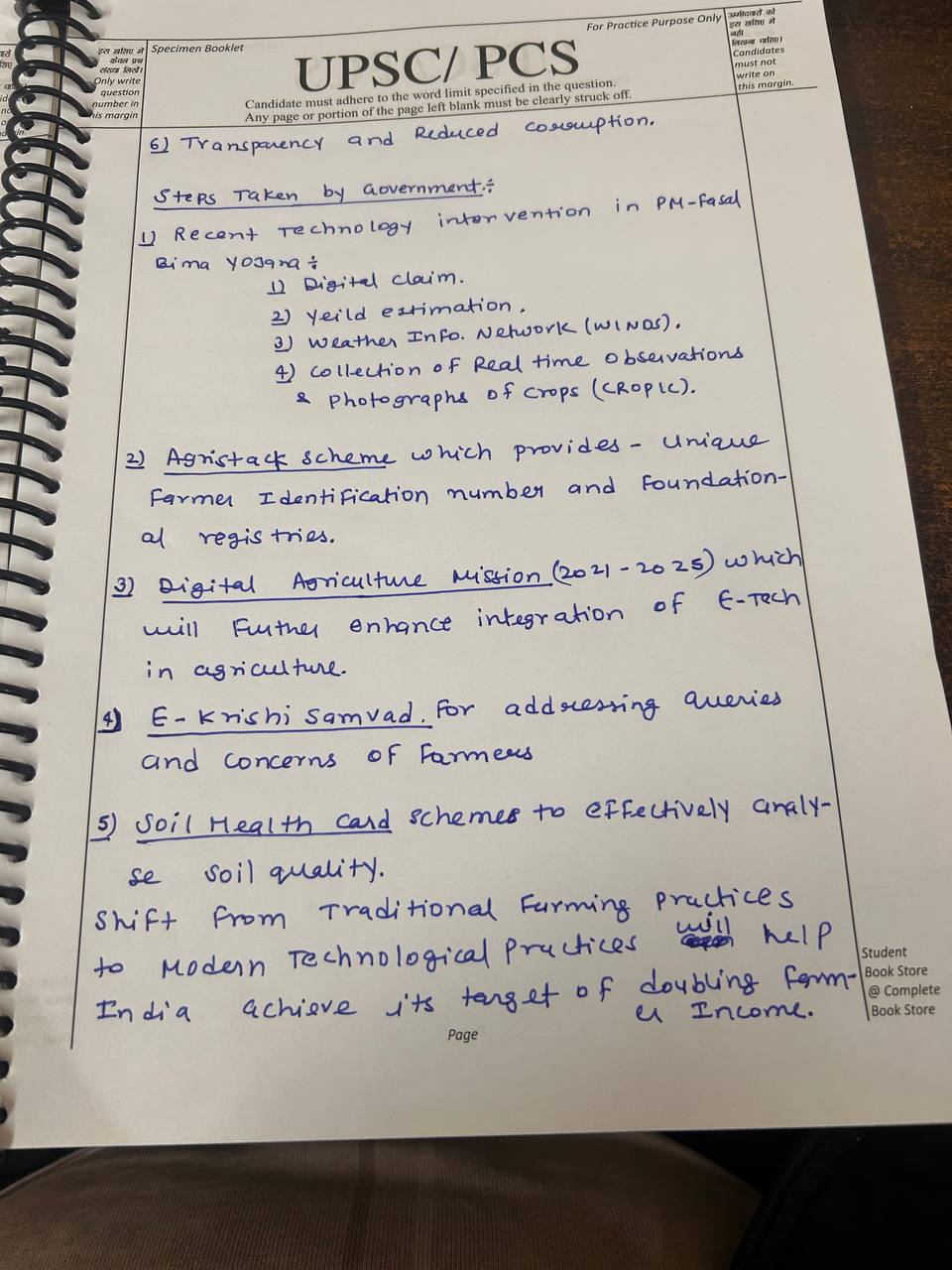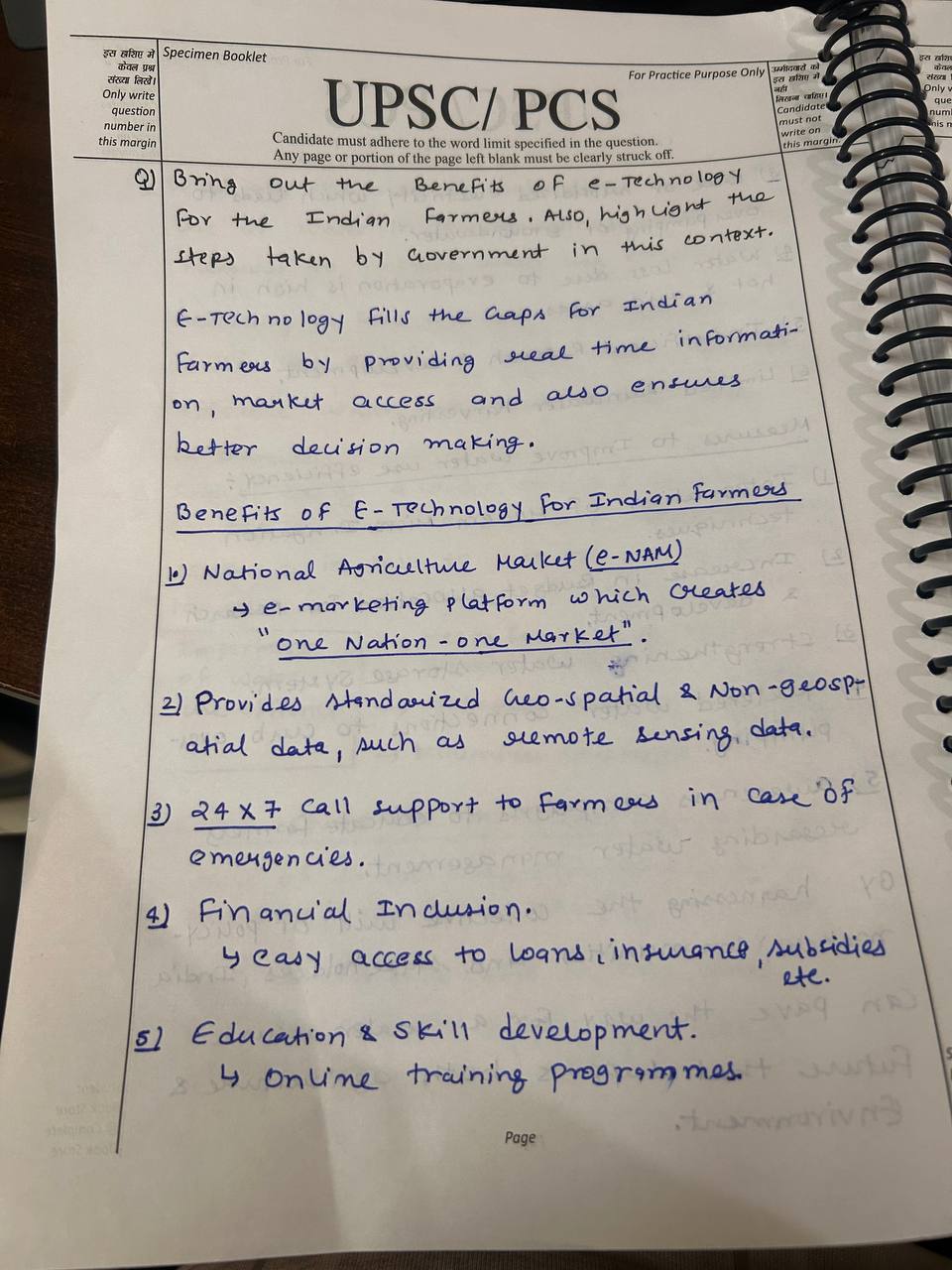Examine how e-learning platforms and digital agricultural extension services can help farmers, especially those in underserved and remote areas, have better access to opportunities for skill development, training, and agricultural knowledge. You should also discuss the difficulties in ensuring digital ...
Impact of Mobile-Based Advisory Services on Agriculture Mobile-based advisory services, such as Kisan Call Centers (KCCs) and Krishi Vigyan Kendras (KVKs), have emerged as crucial tools in providing timely and relevant information to farmers. These services aim to enhance agricultural practices, offRead more
Impact of Mobile-Based Advisory Services on Agriculture
Mobile-based advisory services, such as Kisan Call Centers (KCCs) and Krishi Vigyan Kendras (KVKs), have emerged as crucial tools in providing timely and relevant information to farmers. These services aim to enhance agricultural practices, offer weather forecasts, and provide market prices. Analyzing their impact and discussing the challenges related to scalability and sustainability can provide insights into their effectiveness and areas for improvement.
1. Impact of Mobile-Based Advisory Services
a. Enhancing Agricultural Practices:
i. Timely Information: Mobile-based services provide farmers with timely and practical advice on agricultural practices, which helps in improving productivity:
- Kisan Call Centers (KCCs): KCCs offer expert advice on crop management, pest control, and soil health. For instance:
- Pest Management: Farmers in Punjab have used advice from KCCs to manage pest outbreaks effectively, leading to reduced crop losses.
ii. Knowledge Dissemination: These services help in spreading modern agricultural techniques and practices:
- Krishi Vigyan Kendras (KVKs): KVKs conduct training and demonstrations on advanced farming techniques. For example:
- Soil Health Management: In Uttar Pradesh, KVKs have trained farmers on soil health management practices, resulting in improved soil fertility and crop yields.
b. Providing Weather Forecasts:
i. Risk Management: Accurate weather forecasts help farmers plan their agricultural activities and manage risks related to adverse weather conditions:
- Weather Alerts: Services like IMD’s Agromet Advisory Services (AAS) provide weather forecasts and advisories. For example:
- Cyclone Warnings: Farmers in Odisha received timely warnings about Cyclone Fani, allowing them to take preventive measures and minimize crop damage.
ii. Improved Planning: Access to weather information assists in better planning of sowing, irrigation, and harvesting:
- Seasonal Planning: In Kerala, farmers use weather forecasts to schedule planting and harvesting activities, optimizing crop production.
c. Informing Market Prices:
i. Market Access: Information on market prices helps farmers get fair prices for their produce and avoid exploitation:
- Price Updates: Services like eNAM (Electronic National Agriculture Market) provide real-time price information. For instance:
- Cotton Prices in Gujarat: Farmers in Gujarat have benefited from eNAM by accessing updated cotton prices, leading to better market decisions.
ii. Reducing Middlemen: Direct access to market prices helps reduce dependency on middlemen and improves farmers’ bargaining power:
- Transparency: In Madhya Pradesh, farmers have used price information from eNAM to negotiate better prices for their crops.
2. Challenges in Ensuring Scalability and Sustainability
a. Connectivity Issues:
i. Digital Divide: In rural areas, poor internet and mobile connectivity can hinder access to advisory services:
- Connectivity Gaps: Areas like Ladakh and Arunachal Pradesh face significant connectivity issues, affecting the delivery of mobile-based services.
ii. Infrastructure Development: Lack of infrastructure impacts the effectiveness of these services:
- Network Expansion: Expanding mobile and internet networks to remote areas is essential for improving access. For instance:
- BSNL Initiatives: The Bharat Sanchar Nigam Limited (BSNL) has been working on improving connectivity in underserved regions.
b. Language and Literacy Barriers:
i. Language Diversity: India’s linguistic diversity can create barriers in accessing information if services are not available in local languages:
- Language Support: Ensuring that advisory services are available in regional languages is crucial. For example:
- Mera Gaon Mera Gaurav: This initiative aims to provide information in multiple languages to address the language barrier.
ii. Literacy Challenges: Low literacy levels among farmers can limit their ability to utilize mobile-based services effectively:
- Training Programs: Conducting literacy and training programs to improve the use of these services. For example:
- Digital Literacy Campaigns: Programs by the National Rural Employment Guarantee Act (NREGA) include digital literacy training for rural populations.
c. Scalability of Services:
i. Resource Constraints: Scaling up mobile-based advisory services requires significant resources and infrastructure:
- Funding and Support: Ensuring adequate funding and institutional support for expanding services. For instance:
- Public-Private Partnerships: Collaboration between government and private sector to scale up services effectively.
ii. System Integration: Integrating various advisory services into a coherent system can be challenging:
- Coordination: Ensuring coordination between KCCs, KVKs, and other advisory services for a unified approach. For example:
- Digital Integration: Initiatives like the Digital India Program aim to integrate various digital services for better coordination.
d. Sustainability of Services:
i. Maintenance and Updates: Regular updates and maintenance are needed to keep the services relevant and effective:
- Continuous Improvement: Implementing mechanisms for regular feedback and updates to improve service quality. For instance:
- Feedback Mechanisms: KCCs and KVKs use feedback from farmers to continuously improve their services.
ii. Cost and Funding: Ensuring sustainable funding models for the long-term viability of these services:
- Innovative Models: Exploring innovative funding models, including subsidies, grants, and public-private partnerships, to sustain advisory services.
3. Policy Recommendations
a. Enhancing Connectivity: Investing in infrastructure to improve connectivity in rural areas to ensure wider access to mobile-based services.
b. Language and Literacy Support: Developing multilingual support and literacy programs to address language and literacy barriers.
c. Strengthening Funding and Collaboration: Securing funding and fostering public-private partnerships to scale up and sustain advisory services.
d. Continuous Improvement: Implementing regular updates and feedback mechanisms to enhance the relevance and effectiveness of advisory services.
Conclusion
Mobile-based advisory services like Kisan Call Centers and Krishi Vigyan Kendras play a crucial role in providing farmers with essential information on agricultural practices, weather forecasts, and market prices. While these services offer significant benefits in enhancing agricultural productivity and market access, challenges related to connectivity, language, literacy, scalability, and sustainability need to be addressed. Effective policy interventions and continuous improvements are essential to maximizing the impact of these services and ensuring their long-term success.
See less


E-Learning and Digital Extension Services: Empowering Farmers in Remote and Underserved Areas The rapid digitalization of the agricultural sector has opened up new avenues for farmers to access knowledge, training, and skill development opportunities. In this context, let's discuss the role of e-leaRead more
E-Learning and Digital Extension Services: Empowering Farmers in Remote and Underserved Areas
The rapid digitalization of the agricultural sector has opened up new avenues for farmers to access knowledge, training, and skill development opportunities. In this context, let’s discuss the role of e-learning platforms and digital agricultural extension services, and analyze the challenges in ensuring digital literacy and inclusivity.
1. Improving Access to Agricultural Knowledge and Training
2. Facilitating Skill Development and Capacity Building
3. Ensuring Digital Literacy and Inclusivity
Conclusion
See lessE-learning platforms and digital agricultural extension services have the potential to revolutionize the way farmers access knowledge, training, and skill development opportunities, particularly in remote and underserved areas. However, to ensure the widespread adoption and inclusivity of these digital solutions, policymakers must address the challenges of digital infrastructure, digital literacy, and the diverse needs of the farming community. By adopting a holistic and inclusive approach, the agricultural sector can harness the transformative power of digital technologies and empower farmers to enhance their productivity, sustainability, and resilience.